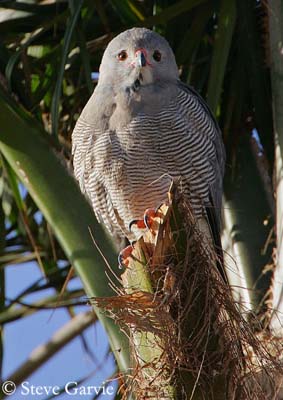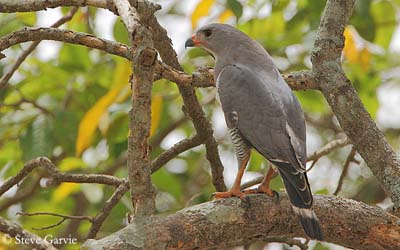
Lizard Buzzard
Kaupifalco monogrammicus
Accipitriforme Order – Accipitridae Family
BIOMETRICS:
Length: 35-38 cm
Weight: M : 220-275 g - F : 248-410 g
LONGEVITY : Up to 9 years
DESCRIPTION:
Lizard Buzzard is a small African bird of prey.
Adult male has grey upperparts, paler face and wing coverts, and pale grey rump. Primary feathers are tipped black, and upper wing is dark grey.
DIET:
Lizard Buzzard feeds mainly on small reptiles such as lizards, geckos and snakes. It also eats small mammals such as rabbits, mice and other rodents, and also small birds killed with its sharp claws. It also hawks insects in flight such as butterflies, bees, wasps, and hunts locusts and ants.
PROTECTION / THREATS / STATUS:
Lizard Buzzard is common throughout its range and all year round. Some decline occurs eastwards, but it is common and widespread in Senegal.
Fr: Autour unibande
All : Sperberbussard
Esp : Busardo Gavilán
Ital : Falco monogrammico
Nd : Hagedisbuizerd
Russe : Ящеричный канюк
Photographers :
Steve Garvie
RAINBIRDER Photo galleries
Jean Marc Rabby
Des Ailes et des Plumes
Texte de Nicole Bouglouan
Sources :
HANDBOOK OF THE BIRDS OF THE WORLD Vol 2 by Josep del Hoyo-Andrew Elliot-Jordi Sargatal - Lynx Edicions - ISBN: 8487334156
BIRDS OF PREY OF AFRICA AND ITS ISLANDS by Alan and Meg Kemp - Struik Publishers - ISBN: 1770073698
BIRDS OF THE GAMBIA AND SENEGAL by Clive Barlow and Tim Wacher – Helm Field guides – ISBN: 0713675497
BirdLife International (BirdLife International)

Underparts are grey. Throat is white with conspicuous vertical black line on centre. Upper breast is unmarked grey, whereas lower breast and belly are white, with narrow dark grey bars. Vent is pale grey. Under wings are white with narrow dark bars, and primaries are tipped black.
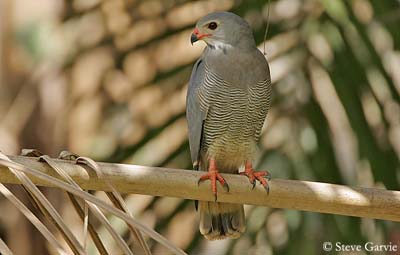
Head is grey with paler face. Hooked bill is black with red cere. Eyes are dark reddish-brown, with orange-red eye-ring. It has short, stout, red legs and feet.
Both sexes are similar, with female larger than male.
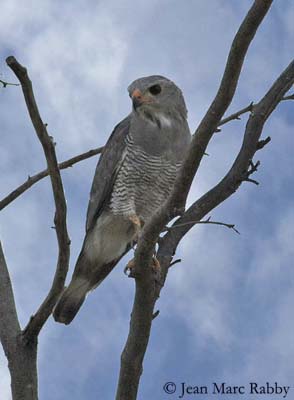
Juvenile resembles adults, but is has back and upper wing feathers tipped with brown, and underparts washed brown. It has pale tips to flight and tail feathers in fresh plumage.
Eyes are brown, then turning pale yellow, before to become reddish-brown at one year. Cere and legs are rather orange than red.
VOICE: SOUNDS BY XENO-CANTO
Lizard Buzzard utters loud “pee-oh” often in series during displays or when it establishes territory. It can also utter series of fluting notes “kli-oo, kluklukluklukluklu” similar to song. It gives these sounds with bill raised upright. It can sometimes call while soaring.
HABITAT:
Lizard Buzzard lives in savannahs with wooded areas. It also frequents riparian woodlands into drier savannahs, clearings and secondary growths.
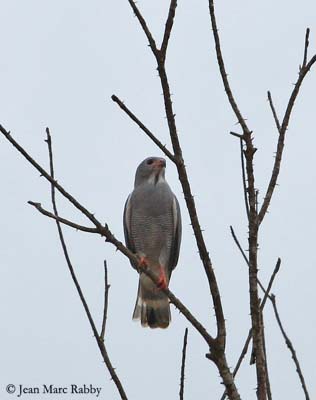
RANGE:
Lizard Buzzard is resident and common, but restricted to savannahs and thorn bush areas in sub-Saharan Africa.
BEHAVIOUR:
Lizard Buzzard is often seen perched alone on exposed branch, on treetop of oil-palms, or wires. It looks fixedly at the ground, searching for preys such as reptiles, large insects, small mammals and birds. It makes short rushes into the grass for food. Poisonous snakes are killed by strike on the head, killing it instantly.

It also hunts while flying. It soars, and performs fast dives at preys caught on the ground or in tall grasses. Lizards are snatched from walls or branches. It can eat the prey on the ground after the capture, but it often carries it back to its perch in order to eat quietly.
Breeding season involves numerous callings from perches in trees, but Lizard Buzzard does not really perform true displays. They are monogamous.
It is a shy species, but male becomes aggressive during nesting period. It can attack large birds with force and abruptly.
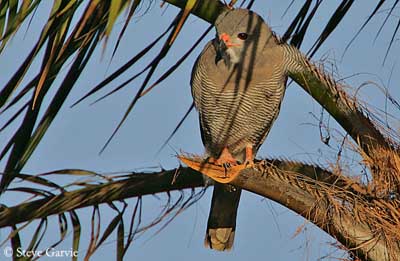
It is resident in its range, and can be nomadic in drier areas. It is often seen singly or in pairs.
FLIGHT:
Lizard Buzzard has an undulating flight. It flies with rapid wing beats, followed by short glides. It soars regularly.
When flying from perch to perch, it usually drops close to the ground, before to perform an undulating flight with series on quick wing beats.
REPRODUCTION:
Breeding season occurs between September and November with some variations according to the range, but it usually occurs in the dry season.
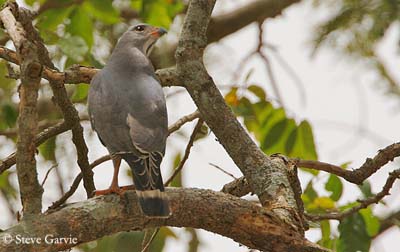
Lizard Buzzard breeds mainly in woodlands, rather than in exotic plantations. Nest is a small platform placed in fork in tree at various heights. It is built by both adults, with one bringing materials while the other builds the solid structure with sticks. Interior is lined with debris, moss and leaves. It is protected from intruders by branches and foliage.
Female lays 1 to 3 white eggs. Incubation is by female. Male feeds her during this period, on the nest or close to it. She sometimes leaves the nest for hunting herself.
Male spends most of its time near the nest. Mates maintain contact by frequent calls.
